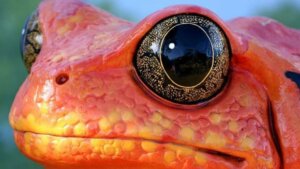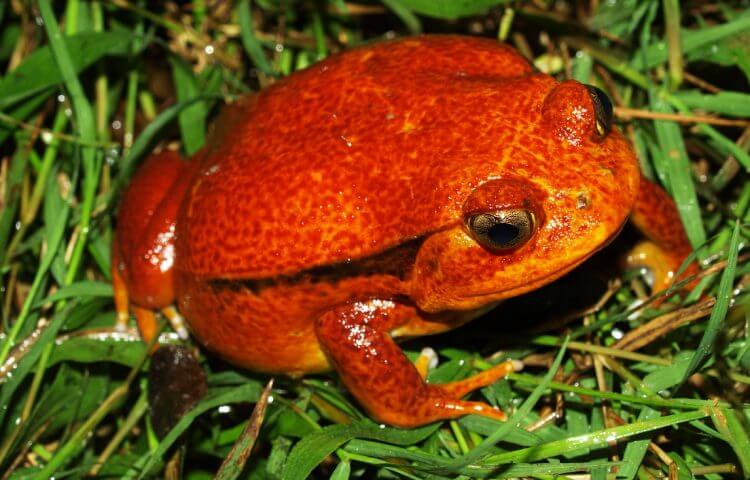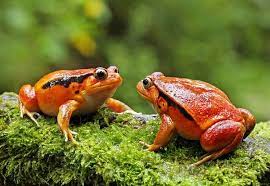Tomato Frogs: Habitat and Characteristics


Written and verified by the biologist Cesar Paul Gonzalez Gonzalez
Tomato frogs are characterized by an intense reddish hue on their skin that’s very striking to the eye. This peculiar trait serves as a warning to its predators, as it secretes a sticky, toxic substance that is unpleasant to the palate. Thanks to this strategy it’s able to survive in its environment.
The scientific name of this species is Dyscophus antongilii and it belongs to the group of anuran amphibians, which groups together all toads and frogs. They’re characterized for being very dependent on water and for moving with small jumps on land. Read on to learn more about the amazing tomato frogs.
Habitat and distribution of the tomato frogs
This amphibian is endemic to northern Madagascar, which includes Antogil Bay, Andevoranto, Maroantsetra, and the Ambatovaky reserve. It can be found in localities at sea level or at a maximum altitude of 600 meters (2000 feet). It can inhabit other areas close to its distribution area, but at first glance, it can be confused with Dyscophus guineti and the boundaries of each are uncertain.
Tomato frogs live in different types of humid habitats such as rainforests, coastal areas, swamps, and in static water bodies. However, it has also adapted to living near urban environments where there are plenty of places to hide.

Species characteristics
This frog measures between 8 and 10 centimeters (3 to 4 inches) in length and exhibits intense red coloration. Its belly has lighter or even white shades. In addition, they show a straight black line from the eyes to the abdomen, which is characteristic of the species. They also exhibit a not very prominent sexual dimorphism, in which females are larger and brighter than males.
The frog’s body is rounded and exhibits some folds on the sides. Its hind legs are larger and sturdier than its front legs, which allow it to hop around. In addition, it’s able to puff itself up to look bigger and more imposing for its competitors. However, this also helps to prevent predators from eating it.
When these frogs feel threatened, they secrete a sticky substance that tastes bad and can cause irritation. Predators that have the misfortune to come into contact with this liquid, will find that it’s very sticky and remains in their mouth or eyes for several days. For humans, this substance doesn’t pose a health hazard. However, in some cases, it can cause allergic reactions.
Behavior
The tomato frog has nocturnal behavior, as it tries to remain hydrated and avoids the hottest hours of the day. It usually hides under leaf litter or among vegetation in bodies of water. This allows it to go unnoticed and to be able to hunt its prey. In fact, it can remain motionless for a very long time in order to achieve its goal.
This amphibian has a mainly insectivorous diet, but it’s also capable of devouring any other compact-sized animal that crosses its path. It’s characterized as a predator that stalks its victims while hiding in vegetation. In addition, it has excellent reflexes that help it to capture its food in just a matter of seconds.
To facilitate swallowing, the tomato frog pushes its eyes into its sockets, as this creates more suction pressure. This allows them to swallow their prey faster and prepare immediately in case another victim should happen to pass by.
Reproduction
The breeding season usually begins after the rainy season, although some have the ability to mate year-round. The only thing they need is a body of water to lay their eggs, as their fertilization is external and they release both gametes (eggs and sperm) into the environment to fertilize them.
This species emits a series of vocalizations that it repeats incessantly to attract its mate. Each male protects a specific area and mates with all the females within it. For this process, it uses a strategy called amplexus, which consists of a type of “embrace” in which both individuals approach each other and release their gametes into the water at the same time.
The female is capable of releasing between 1000 and 1500 eggs in each clutch. Each of these will hatch about 36 hours later and produce a tadpole (larva). These small fish-like larvae will feed on organic matter suspended in the water. Once they reach sufficient size, they will go through a metamorphosis that will change their entire body and take on the appearance of an adult frog.

Conservation status
The International Union for Conservation of Nature classifies the tomato frog as a species of least concern. This is due to it being highly resistant to habitat disturbance and able to reproduce all year-round. Both of these aspects seem to have kept its population stable, and it even seems to be growing.
The characteristics of this amphibian have made it the target of several exotic pet lovers. In fact, it’s relatively easy to get it to reproduce in captivity, and so it has become overly widespread. However, it’s important to remember the irritating stick substance we told you about earlier, which can cause inflammation. Keep in mind that not all species are suitable for captivity, and not all keepers are prepared to look after them.
Tomato frogs are characterized by an intense reddish hue on their skin that’s very striking to the eye. This peculiar trait serves as a warning to its predators, as it secretes a sticky, toxic substance that is unpleasant to the palate. Thanks to this strategy it’s able to survive in its environment.
The scientific name of this species is Dyscophus antongilii and it belongs to the group of anuran amphibians, which groups together all toads and frogs. They’re characterized for being very dependent on water and for moving with small jumps on land. Read on to learn more about the amazing tomato frogs.
Habitat and distribution of the tomato frogs
This amphibian is endemic to northern Madagascar, which includes Antogil Bay, Andevoranto, Maroantsetra, and the Ambatovaky reserve. It can be found in localities at sea level or at a maximum altitude of 600 meters (2000 feet). It can inhabit other areas close to its distribution area, but at first glance, it can be confused with Dyscophus guineti and the boundaries of each are uncertain.
Tomato frogs live in different types of humid habitats such as rainforests, coastal areas, swamps, and in static water bodies. However, it has also adapted to living near urban environments where there are plenty of places to hide.

Species characteristics
This frog measures between 8 and 10 centimeters (3 to 4 inches) in length and exhibits intense red coloration. Its belly has lighter or even white shades. In addition, they show a straight black line from the eyes to the abdomen, which is characteristic of the species. They also exhibit a not very prominent sexual dimorphism, in which females are larger and brighter than males.
The frog’s body is rounded and exhibits some folds on the sides. Its hind legs are larger and sturdier than its front legs, which allow it to hop around. In addition, it’s able to puff itself up to look bigger and more imposing for its competitors. However, this also helps to prevent predators from eating it.
When these frogs feel threatened, they secrete a sticky substance that tastes bad and can cause irritation. Predators that have the misfortune to come into contact with this liquid, will find that it’s very sticky and remains in their mouth or eyes for several days. For humans, this substance doesn’t pose a health hazard. However, in some cases, it can cause allergic reactions.
Behavior
The tomato frog has nocturnal behavior, as it tries to remain hydrated and avoids the hottest hours of the day. It usually hides under leaf litter or among vegetation in bodies of water. This allows it to go unnoticed and to be able to hunt its prey. In fact, it can remain motionless for a very long time in order to achieve its goal.
This amphibian has a mainly insectivorous diet, but it’s also capable of devouring any other compact-sized animal that crosses its path. It’s characterized as a predator that stalks its victims while hiding in vegetation. In addition, it has excellent reflexes that help it to capture its food in just a matter of seconds.
To facilitate swallowing, the tomato frog pushes its eyes into its sockets, as this creates more suction pressure. This allows them to swallow their prey faster and prepare immediately in case another victim should happen to pass by.
Reproduction
The breeding season usually begins after the rainy season, although some have the ability to mate year-round. The only thing they need is a body of water to lay their eggs, as their fertilization is external and they release both gametes (eggs and sperm) into the environment to fertilize them.
This species emits a series of vocalizations that it repeats incessantly to attract its mate. Each male protects a specific area and mates with all the females within it. For this process, it uses a strategy called amplexus, which consists of a type of “embrace” in which both individuals approach each other and release their gametes into the water at the same time.
The female is capable of releasing between 1000 and 1500 eggs in each clutch. Each of these will hatch about 36 hours later and produce a tadpole (larva). These small fish-like larvae will feed on organic matter suspended in the water. Once they reach sufficient size, they will go through a metamorphosis that will change their entire body and take on the appearance of an adult frog.

Conservation status
The International Union for Conservation of Nature classifies the tomato frog as a species of least concern. This is due to it being highly resistant to habitat disturbance and able to reproduce all year-round. Both of these aspects seem to have kept its population stable, and it even seems to be growing.
The characteristics of this amphibian have made it the target of several exotic pet lovers. In fact, it’s relatively easy to get it to reproduce in captivity, and so it has become overly widespread. However, it’s important to remember the irritating stick substance we told you about earlier, which can cause inflammation. Keep in mind that not all species are suitable for captivity, and not all keepers are prepared to look after them.
All cited sources were thoroughly reviewed by our team to ensure their quality, reliability, currency, and validity. The bibliography of this article was considered reliable and of academic or scientific accuracy.
- Andreone, F., Mattioli, F., Guarino, F. M., Tessa, G., & Giacoma, C. (2007). Longevity and body size in three populations of Dyscophus antongilii, Microhylidae, Dyscophinae, the tomato frog from north-eastern Madagascar.
- Segev, O., Andreone, F., Pala, R., Tessa, G., & Vences, M. (2012). Reproductive phenology of the tomato frog, Dyscophus antongili, in an urban pond of Madagascar’s east coast. Acta Herpetologica, 7(2), 331-340.
- Evans, C. M., & Brodie, E. D. (1994). Adhesive strength of amphibian skin secretions. Journal of Herpetology, 28(4), 499-502.
- IUCN SSC Amphibian Specialist Group. (2017). Dyscophus antongilii. The IUCN Red List of Threatened Species 2017: e.T6937A84159360. https://dx.doi.org/10.2305/IUCN.UK.2017-2.RLTS.T6937A84159360.en.
This text is provided for informational purposes only and does not replace consultation with a professional. If in doubt, consult your specialist.








